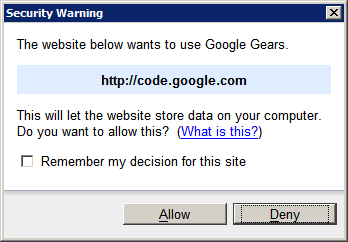Google Gears
 Gears is a browser plugin that allows you to run standalone web applications. Google uploads it online on May 31, 2007, under a free license and open source, first under the name Google Gears, and then renamed Gears.
Gears is a browser plugin that allows you to run standalone web applications. Google uploads it online on May 31, 2007, under a free license and open source, first under the name Google Gears, and then renamed Gears.
Runs on Internet Explorer, Firefox, Chrome, Safari, Opera and major current operating systems.
This is the main interest on this site, web applications should also work locally, because the connection is not always possible or desirable, or applications are too slow, and on the other hand, because it is better for the programmer not to choose between a local environment or the web.
Google Gears brings a stone to the building of these versatile apps.
For example, Gmail messages can be read without connecting to the Internet or using Google Reader in the same way.
Gears consists of three JavaScript modules:
- LocalServer. It buffers resources and returns them as needed.
- DataBase. Writes data locally to the SQLite database.
- WorkerPool (agent group). Makes applications faster by asynchronously delivering resources (therefore, it is an Ajax extension).
Google has decided to turn to HTML 5 for offline applications, so it is highly recommended to use HTML 5 for new long-term developments. For immediate and mobile use, Gear remains the solution.
Battle of plugins
Google describes it this way: "Gears is an incremental improvisation for the internet as it is today. It adds просто enough to AJAX to make current web applications work offline". Translation: Gears is an incremental improvement on the web in its current form. It just adds enough to Ajax for current web applications to run offline.
This is the result of a collaboration with Mozilla, Adobe and Opera to create functionality that was also developed by Mozilla for Firefox 3. It will be more general and will work with all interfaces, so Silverlight will directly compete with Flash.
So we see that Microsoft's announcement of XAML-based Silverlight, a very ambitious project that could extend Windows' superiority to the Internet, is making competitors react. Adobe, which had previously decided to open source its rival Flex technology, joined Google in sharing its Apollo environment code.
So Google may even be competing with Microsoft on its land, in office software.
Google Gears capabilities
The plugin will include SQLite, a database manager for local storage, so that applications will have data without a network connection.
It will allow applications already written and running on the Web to become desktop applications.
On the other hand, local applications can be expanded using the capabilities of the Web, such as search engines that will collect data online for offline use.
Runtime Gears only launches online. Even if you want to use the browser as a platform and define an application to work locally, you need to upload it to the Internet and post it on the site for the first time, and then use it offline.
Thus, the system is mainly suitable for the service provided by the website, it will be downloaded as software and can work on the desktop without connecting to the site until the update.
How it works in practice
 Before going offline, the browser with the extension asks for permission.
Before going offline, the browser with the extension asks for permission.
The resources used by the program are then stored in a buffer, where they can be found without a connection when the data is saved to a SQLite file.
To go offline, press the button, and the backup of data and resources begins.
Therefore, we will have to connect from time to time to get data from the Web.
Gears and others
Gears appears in the context of progress or the same innovations are made by multiple products at the same time. Thus, it can be approximated to the following instruments:
- Chromeless by Mozilla. Allows you to run web applications from the desktop (but in connected mode).
- Adobe Air. This environment for rich Internet applications has an offline mode.
HTML 5 provides for offline operation, but its implementation will depend on browsers. Google fully supports HTML 5 and considers Gears a temporary tool.
Gears is licensed under a BSD license.
Dojo's infrastructure is outdated, but now includes Gears .
Silverlight isn't like that, but Gears is more mobile. AIR from Adobe (formerly Apollo) will include Gears for Flash applications.